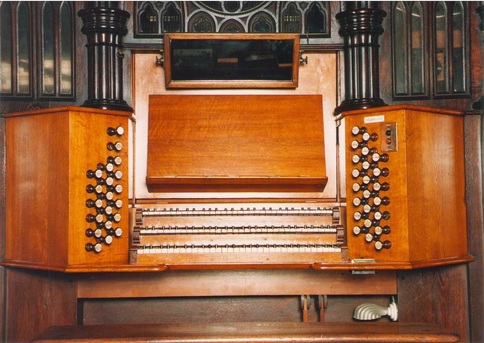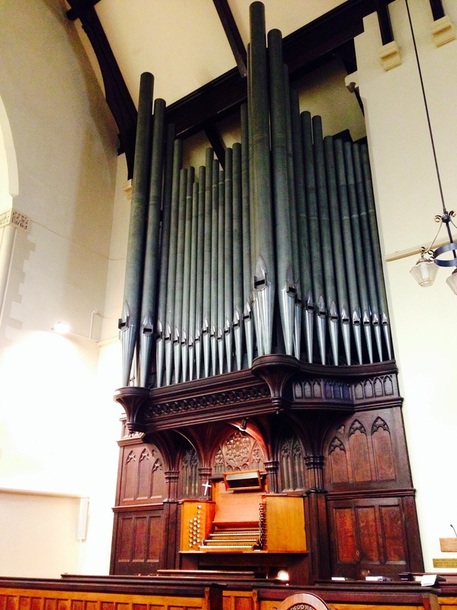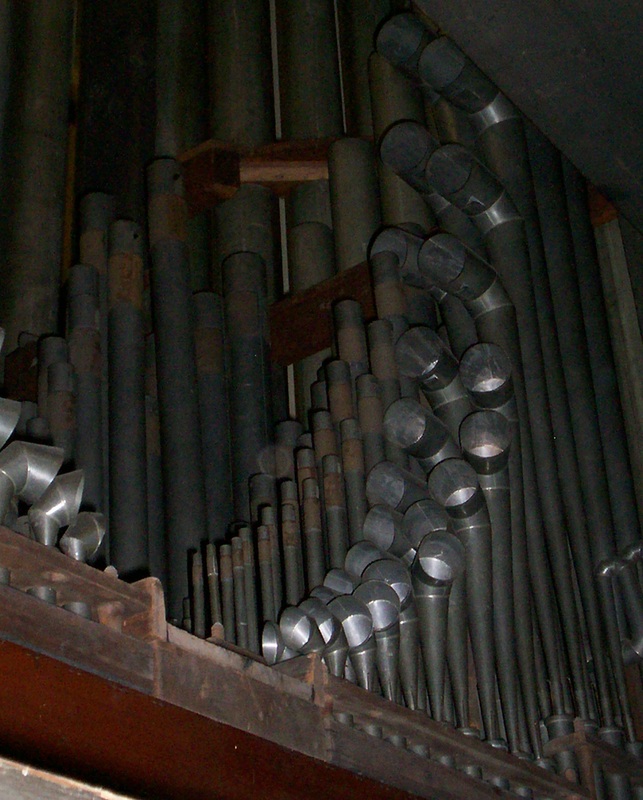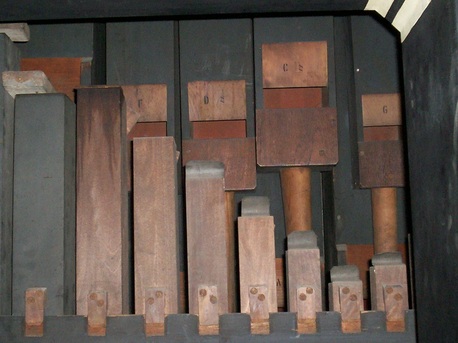Yr Organ
|
(English version below)
Adeiladwyd yr organ gan ‘Y Tad’ Henry Willis ym 1887. Mae’n un o ddau offeryn a adeiladwyd ganddo yng Nghaerdydd. Adeiladwyd y llall ym 1894 ac fe’i gwelir yn Eglwys Sant Ioan Fedyddiwr. Roedd Willis hefyd wedi adeiladu organ yn Theatr y Park Hall nad yw bellach yn bodoli. Bu Edwin Lemare, yr organydd a’r cyfansoddwr enwog, yn organydd yno a hefyd yn Eglwys Sant Andreas sydd erbyn hyn yn gartref i Eglwys Dewi Sant. Mae gan organ Eglwys Dewi Sant dri chwaraefwrdd, pedalau a chyfanswm o 33 stop siarad, 7 stop cyplu a 1,732 o bibellau. Mabwysiadodd Willis nifer o arweithiau ar ei chyfer ac mae’r rhain yn parhau hyd heddiw. Dyma un rheswm pam y cynhaliwyd ysgolion haf cerdd y Brifysgol Agored yma fel rhan o’u hastudiaethau hanes offeryniaeth. Mae’r brif organ (great) yn gweithio ar egwyddor y floating lever a ddatblygwyd gan Vincent, mab Henry Willis. Mae’r organ chwyddo (swell) a’r organ gôr (choir) yn enghreifftiau o arwaith cysylltbren (tracker) clodwiw ‘Y Tad’ Willis, a thrwy ddewis arwaith niwmatig ar gyfer y pedalau llwyddodd i ymestyn y diapason agored 16 a’r bwrdon 16 i 8’. |

Ym 1927 gwnaed yr ychwanegiadau canlynol gan gwmni Sweetland (roeddent eisoes wedi’u paratoi gan Willis):
YR ORGAN CHWYDDO:
Contra Fagotto 16; Vox Humana 8;
Vox Angelica 8; Tremulant
YR ORGAN GÔR:
Orchestral Oboe 8
Y PEDALAU:
Trombone 16
Y STOPIAU CYPLU:
Swell to Choir (cafodd hwn ei ddiddymu
yn ystod gwaith adfer 1980)
Cafodd y tremulant ar yr organ gôr ei osod gan gwmni Blackett a Howden. Ym 1956 rhoddwyd ifori newydd ar y chwaraefyrddau ac fe osodwyd y peiriant chwythu presennol.
Argymhellodd Lawrence Phelps, yr adeiladwr organ Americanaidd nodedig, bod Peter Hindmarsh o Gaerdydd yn ymgymryd â gwaith adfer cyflawn. Ym 1980 cafodd y pibellau Willis eu glanhau, eu hatgyweirio a’u cymhwyso ond ni chawsant eu hail-leisio ac ni wnaed unrhyw newid iddynt. Ail-leisiwyd y Contra Fagotto a’r Trombone gan gwmni Rogers o Leeds er mwyn ceisio gwella ansawdd tôn a lleferydd. Gosodwyd setiau o bibellau 19eg ganrif yn lle Vox Humana Sweetland, gwnaed gwelliant i’r system wynt ac fe ddychwelwyd y pwysau gwynt i’w lefelau gwreiddiol. Er mwyn hwyluso mynediad ar gyfer gwaith cynnal a chadw a thiwnio, amnewidiwyd y brif fegin anferth ac fe osodwyd golau ym mhob rhan o’r offeryn.
YR ORGAN CHWYDDO:
Contra Fagotto 16; Vox Humana 8;
Vox Angelica 8; Tremulant
YR ORGAN GÔR:
Orchestral Oboe 8
Y PEDALAU:
Trombone 16
Y STOPIAU CYPLU:
Swell to Choir (cafodd hwn ei ddiddymu
yn ystod gwaith adfer 1980)
Cafodd y tremulant ar yr organ gôr ei osod gan gwmni Blackett a Howden. Ym 1956 rhoddwyd ifori newydd ar y chwaraefyrddau ac fe osodwyd y peiriant chwythu presennol.
Argymhellodd Lawrence Phelps, yr adeiladwr organ Americanaidd nodedig, bod Peter Hindmarsh o Gaerdydd yn ymgymryd â gwaith adfer cyflawn. Ym 1980 cafodd y pibellau Willis eu glanhau, eu hatgyweirio a’u cymhwyso ond ni chawsant eu hail-leisio ac ni wnaed unrhyw newid iddynt. Ail-leisiwyd y Contra Fagotto a’r Trombone gan gwmni Rogers o Leeds er mwyn ceisio gwella ansawdd tôn a lleferydd. Gosodwyd setiau o bibellau 19eg ganrif yn lle Vox Humana Sweetland, gwnaed gwelliant i’r system wynt ac fe ddychwelwyd y pwysau gwynt i’w lefelau gwreiddiol. Er mwyn hwyluso mynediad ar gyfer gwaith cynnal a chadw a thiwnio, amnewidiwyd y brif fegin anferth ac fe osodwyd golau ym mhob rhan o’r offeryn.
|
Dymuniad Eglwys Dewi Sant oedd cyflawni gwaith adfer a oedd yn cyd-weddu â’r gwaith gwreiddiol, yn hytrach nag ail-adeiladu’r offeryn. Fel canlyniad i hyn cadwyd llawer o’r nodweddion gwreiddiol e.e. adferwyd yr wyth pedal cyfuno a’r clicedi i gysgodlenni’r organ chwyddo a’r organ gôr, ac mae’r traw uchel yn parhau.
Mae nifer o organyddion enwog wedi perfformio yn Eglwys Dewi Sant yn dilyn y gwaith adfer a wnaed gan Peter Hindmarsh ym 1980. Yn eu plith mae’r Fonesig Gillian Weir, Peter Hurford, Jane Watts, Roy Massey, John Scott ynghyd ag organyddion o Rwsia, UDA, Ffrainc a’r Almaen. Mae cadw’r nodweddion gwreiddiol yn golygu nad yw’r organ hon yn un hawdd iawn i’w chwarae. Er hyn, mae’r gwaith adfer ystyriol a wnaed, ansawdd rhagorol y deunyddiau a ddefnyddiwyd, y crefftwaith ardderchog a’r sain ysblennydd yn cyfiawnhau’r hyn a ddywedodd Peter Hurford, sef bod [organ] ‘Y Tad’ Willis yn Eglwys Dewi Sant yn enghraifft rhagorol o organ Fictoraidd. Detholiad o waith gwreiddiol gan Philip Laugharne |
Manylion yr Organ
|
Y BRIF ORGAN
Diapason Dwbl 16 Diapason Agored 8 Diapason Agored 8 Ffliwt Claribel 8 Principal 4 Ffliwt Harmonig 4 Deuddegfed 2⅔ Pymthegfed 2 Trwmped 8 YR ORGAN CHWYDDO Bwrdon Lieblich 16 Geigen Principal 8 Lieblich Gedackt 8 Helygbib (Salicional) 8 Vox Angelica 8 Gemshorn 4 Flageolet 2 Contra Fagotto 16 Cornopean 8 Obo 8 Vox Humana 8 Tremwlant |
YR ORGAN GÔR
Viole D’Amore 8 Lieblich Flute 8 Dulciana 8 Lieblich Flute 4 Concert Flute 4 Picolo 2 Clarinet 8 Obo Cerddorfaol 8 Tremwlant PEDAL Diapason Agored (pren) 16 Bwrdon 16 Wythfed 8 Bas-ffliwt 8 Trombôn 16 Y STOPIAU CYPLU (COUPLERS) Wythfed Organ Chwyddo i’r Brif Organ Organ Chwyddo i’r Brif Organ Is-wythfed Organ Chwyddo i’r Brif Organ Organ Gôr i’r Brif Organ Prif Organ i Bedal Organ Chwyddo i Bedal Organ Gôr i Bedal |
Pedalau Cyfuno
Y Brif Organ: 1. Diapason Bach Agored 8
2. Diapason Bach Agored 8, Principal 4
3. Diapason bach Agored 8, Principal 4, Deuddegfed 2⅔, Pymthegfed 2
Yr Organ Chwyddo : 1. Lieblich Gedackt 8
2. Gemshorn 4, Geigen Principal 8
3. Gemshorn 4, Flageolet 2, Cornopean 8, Geigen 8
Pedal: 1. Bwrdon 16, Bas-ffliwt 8
2. Bwrdon 16, Bas-ffliwt 8, Diapason Agored 16, Wythfed 8
Y Brif Organ: 1. Diapason Bach Agored 8
2. Diapason Bach Agored 8, Principal 4
3. Diapason bach Agored 8, Principal 4, Deuddegfed 2⅔, Pymthegfed 2
Yr Organ Chwyddo : 1. Lieblich Gedackt 8
2. Gemshorn 4, Geigen Principal 8
3. Gemshorn 4, Flageolet 2, Cornopean 8, Geigen 8
Pedal: 1. Bwrdon 16, Bas-ffliwt 8
2. Bwrdon 16, Bas-ffliwt 8, Diapason Agored 16, Wythfed 8
The Organ
The organ was built by ‘Father’ Henry Willis in 1887. It is one of two instruments in Cardiff built by ‘Father’ Willis. The other, which was completed in 1894, is in the church of St John the Baptist. Willis had also built an organ at the Park Hall Theatre which no longer exists. Edwin Lemare, the famous organist and composer was organist there and also at St Andrew’s Church which since 1956 has been the home of Eglwys Dewi Sant.
The organ consists of three manuals and pedals with a total of 33 speaking stops, 7 couplers and 1,732 pipes. Willis adopted various actions for the instrument and these have been retained. This was one reason why the Open University Music Summer Schools came to Eglwys Dewi Sant as part of their history of instrumentation studies. The Great organ action is a ‘floating lever’ developed by Willis’s son Vincent. The Swell and Choir organs are examples of Willis’s fine tracker actions, while by adopting pneumatic action to the Pedal organ, he was able to extend the Open Diapason 16 and the Bourdon 16 to 8’ pitch.
In 1927 the Sweetland Company made the following additions which had been prepared by Willis:
SWELL: Contra Fagotto 16; Vox Humana 8; Vox Angelica 8; Tremulant
CHOIR: Orchestral Oboe 8
PEDAL: Trombone 16
COUPLERS: Swell to Choir (this was removed during the 1980 restoration)
The Choir Tremulant was installed by Blackett and Howden and in 1956 new ivories were fitted to the manuals and the present blower was installed.
In 1980 Peter Hindmarsh of Cardiff was recommended by Lawrence Phelps the distinguished American organ builder to carry out a complete restoration of the instrument. The Willis pipe-work was cleaned, repaired and regulated but was not altered or re-voiced. Both the Sweetland Contra Fagotto and the Trombone were re-voiced by the Rogers Company from Leeds in an effort to improve the quality of both speech and tone. The Sweetland Vox Humana was replaced with a rank of 19th century pipe-work. The wind system was improved and wind pressures were restored to their original levels. To facilitate access for maintenance and tuning the massive primary bellows was replaced and lighting was installed in all parts of the instrument.
Eglwys Dewi Sant desired a sympathetic restoration rather than a rebuilding of the organ and many original features were retained, e.g. the eight combination pedals, the triggers to the Swell and Choir shutters were restored and the ‘sharp’ pitch was retained.
Since the restoration by Peter Hindmarsh in 1980 a number of renowned organists have performed at Eglwys Dewi Sant. These include Dame Gillian Weir, Peter Hurford, Jane Watts, Roy Massey, John Scott as well as organists from Russia, USA, France and Germany.
The retention of the original features has meant that this organ is not the easiest instrument to play. However, its sympathetic restoration, the fine quality of the materials used, the excellent workmanship and its superb sound justifies Peter Hurford’s remark that the [Eglwys] Dewi Sant Father Willis “is a very fine example of a Victorian organ”.
Extract from an original work by Philip Laugharne
The organ consists of three manuals and pedals with a total of 33 speaking stops, 7 couplers and 1,732 pipes. Willis adopted various actions for the instrument and these have been retained. This was one reason why the Open University Music Summer Schools came to Eglwys Dewi Sant as part of their history of instrumentation studies. The Great organ action is a ‘floating lever’ developed by Willis’s son Vincent. The Swell and Choir organs are examples of Willis’s fine tracker actions, while by adopting pneumatic action to the Pedal organ, he was able to extend the Open Diapason 16 and the Bourdon 16 to 8’ pitch.
In 1927 the Sweetland Company made the following additions which had been prepared by Willis:
SWELL: Contra Fagotto 16; Vox Humana 8; Vox Angelica 8; Tremulant
CHOIR: Orchestral Oboe 8
PEDAL: Trombone 16
COUPLERS: Swell to Choir (this was removed during the 1980 restoration)
The Choir Tremulant was installed by Blackett and Howden and in 1956 new ivories were fitted to the manuals and the present blower was installed.
In 1980 Peter Hindmarsh of Cardiff was recommended by Lawrence Phelps the distinguished American organ builder to carry out a complete restoration of the instrument. The Willis pipe-work was cleaned, repaired and regulated but was not altered or re-voiced. Both the Sweetland Contra Fagotto and the Trombone were re-voiced by the Rogers Company from Leeds in an effort to improve the quality of both speech and tone. The Sweetland Vox Humana was replaced with a rank of 19th century pipe-work. The wind system was improved and wind pressures were restored to their original levels. To facilitate access for maintenance and tuning the massive primary bellows was replaced and lighting was installed in all parts of the instrument.
Eglwys Dewi Sant desired a sympathetic restoration rather than a rebuilding of the organ and many original features were retained, e.g. the eight combination pedals, the triggers to the Swell and Choir shutters were restored and the ‘sharp’ pitch was retained.
Since the restoration by Peter Hindmarsh in 1980 a number of renowned organists have performed at Eglwys Dewi Sant. These include Dame Gillian Weir, Peter Hurford, Jane Watts, Roy Massey, John Scott as well as organists from Russia, USA, France and Germany.
The retention of the original features has meant that this organ is not the easiest instrument to play. However, its sympathetic restoration, the fine quality of the materials used, the excellent workmanship and its superb sound justifies Peter Hurford’s remark that the [Eglwys] Dewi Sant Father Willis “is a very fine example of a Victorian organ”.
Extract from an original work by Philip Laugharne
The Specification
|
GREAT
Double Diapason 16 Open Diapason 8 Open Diapason 8 Claribel Flute 8 Principal 4 Harmonic Flute 4 Twelfth 2⅔ Fifteenth 2 Trumpet 8 SWELL Lieblich Bourdon 16 Geigen Principal 8 Lieblich Gedackt 8 Salicional 8 Vox Angelica 8 Gemshorn 4 Flageolet 2 Contra Fagotto 16 Cornopean 8 Oboe 8 Vox Humana 8 Tremulant |
CHOIR
Viole D’Amore 8 Lieblich Flute 8 Dulciana 8 Lieblich Flute 4 Concert Flute 4 Piccolo 2 Clarinet 8 Orchestral Oboe 8 Tremulant PEDAL Open Diapason (wood) 16 Bourdon 16 Octave 8 Bass Flute 8 Trombone 16 COUPLERS Swell Octave to Great Swell to Great Swell Sub-0ctave to Great Choir to Great Great to Pedal Swell to Pedal Choir to Pedal |
Combination Pedals
Swell: 1. Lieblich Gedackt 8
2. Gemshorn 4, Geigen Principal 8
3. Gemshorn 4, Flageolet 2, Cornopean 8, Geigen 8
Great: 1. Small Open Diapason 8
2. Small Open Diapason 8, Principal 4
3. Small Open Diapason 8, Principal 4, Twelfth 2⅔, Fifteenth 2
Pedal: 1. Bourdon 16, Bass Flute 8
2. Bourdon 16, Bass Flute 8, Open Diapason 16, Octave 8
Wind Pressures
Great 3½”
Swell 3¾”
Choir 3½”
Pedal 3½”
Great Trumpet 6”
Pedal Trombone 6”
Action 3½”
Swell: 1. Lieblich Gedackt 8
2. Gemshorn 4, Geigen Principal 8
3. Gemshorn 4, Flageolet 2, Cornopean 8, Geigen 8
Great: 1. Small Open Diapason 8
2. Small Open Diapason 8, Principal 4
3. Small Open Diapason 8, Principal 4, Twelfth 2⅔, Fifteenth 2
Pedal: 1. Bourdon 16, Bass Flute 8
2. Bourdon 16, Bass Flute 8, Open Diapason 16, Octave 8
Wind Pressures
Great 3½”
Swell 3¾”
Choir 3½”
Pedal 3½”
Great Trumpet 6”
Pedal Trombone 6”
Action 3½”



